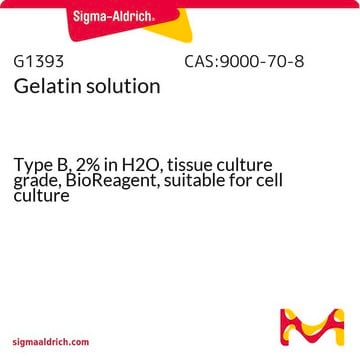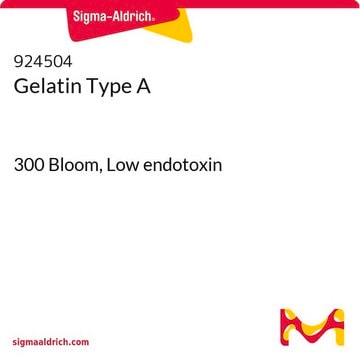918644
Low endotoxin gelatin solution
gel strength (bloom 300)
Synonym(e):
Type A, Bloom 300
Anmeldenzur Ansicht organisationsspezifischer und vertraglich vereinbarter Preise
Alle Fotos(1)
About This Item
UNSPSC-Code:
12352202
NACRES:
NA.23
Empfohlene Produkte
Form
viscous liquid
Qualitätsniveau
Konzentration
20 wt. % in DPBS (buffer)
Verunreinigungen
<25 EU/mL Endotoxin
<5 cfu/mL Bioburden
Farbe
colorless to pale yellow
pH-Wert
6.5-7.5
Lagertemp.
2-8°C
Verwandte Kategorien
Anwendung
Low endotoxin gelatin solution is a 20% low endotoxin gelatin solution in DPBS buffer. It is sterile filtrated through 0.2 μm sterile filter, and ready to be used in biomedical applications.
Gelatin is widely used for tissue engineering and 3D bioprinting. Gelatin is derived from natural extracellular matrix (ECM) components. Due to its low cost, abundance, and retention of natural cell binding motifs, gelatin has become a highly sought material for tissue engineering applications. Gelatin solution has thermoreversible gelling property which enables synthesis of biocompatible and biodegradable hydrogels and promote cell adhesion, spreading, and proliferation.
Gelatin is widely used for tissue engineering and 3D bioprinting. Gelatin is derived from natural extracellular matrix (ECM) components. Due to its low cost, abundance, and retention of natural cell binding motifs, gelatin has become a highly sought material for tissue engineering applications. Gelatin solution has thermoreversible gelling property which enables synthesis of biocompatible and biodegradable hydrogels and promote cell adhesion, spreading, and proliferation.
Verpackung
10 mL in glass bottle
Lagerklassenschlüssel
10 - Combustible liquids
WGK
WGK 3
Hier finden Sie alle aktuellen Versionen:
Analysenzertifikate (COA)
Lot/Batch Number
Die passende Version wird nicht angezeigt?
Wenn Sie eine bestimmte Version benötigen, können Sie anhand der Lot- oder Chargennummer nach einem spezifischen Zertifikat suchen.
Besitzen Sie dieses Produkt bereits?
In der Dokumentenbibliothek finden Sie die Dokumentation zu den Produkten, die Sie kürzlich erworben haben.
J M Harlan et al.
Laboratory investigation; a journal of technical methods and pathology, 48(3), 269-274 (1983-03-01)
Lipopolysaccharide (LPS) produced time- and dose-dependent bovine endothelial cell injury in vitro that was manifested initially by cell detachment from culture substrate with subsequent cell lysis. Bovine endothelial cell injury was observed with LPS derived from Salmonella minnesota R595, a
E J Ziegler et al.
The New England journal of medicine, 307(20), 1225-1230 (1982-11-11)
In an effort to decrease deaths from gram-negative bacteremia and endotoxin shock, we treated bacteremic patients with human antiserum to endotoxin (lipopolysaccharide) core. Antiserum was prepared by vaccinating healthy men with heat-killed Escherichia coli J5; this mutant lacks lipopolysaccharide oligosaccharide
K W Brunson et al.
Journal of supramolecular structure, 9(2), 231-242 (1978-01-01)
Chinese hamster ovary (CHO . K1 . PRO) cell growth was inhibited by addition of a gram-negative bacterial lipopolysaccharide (LPS) to the cell culture medium. Growth inhibition began after three or four days of incubation, was dose-dependent up to a
J Ongrádi et al.
Folia microbiologica, 29(6), 450-454 (1984-01-01)
Cytotoxicity of a mixed pyrogen preparation and its components as well as native and radiodetoxified lipopolysacharides (LPS) was determined with established HEp-2 cell cultures and by measuring plating efficiency. This proved to be more sensitive to the damaging effect of
J G Brock-Utne et al.
Anaesthesia and intensive care, 17(1), 49-55 (1989-02-01)
Endotoxins (lipopolysaccharides, LPS) are potent bacterial poisons always present within the intestines in considerable amounts. Several pathophysiological conditions such as hypovolaemia, hypoxia, intestinal ischaemia, burns and radiation lead to a breakdown in the barrier and depending upon the extent of
Unser Team von Wissenschaftlern verfügt über Erfahrung in allen Forschungsbereichen einschließlich Life Science, Materialwissenschaften, chemischer Synthese, Chromatographie, Analytik und vielen mehr..
Setzen Sie sich mit dem technischen Dienst in Verbindung.








